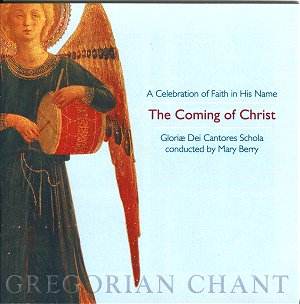I must confess that I have not always been enthusiastic
about Gloriae Dei Cantores’ records in the past. Here, the Schola
is directed by Dr. Mary Berry in a programme of plainchant themed
around Christ's Nativity, much of the chant being from Advent
and Christmas. On this recording, the sound engineers have managed
to strike the right balance between clarity and sympathy. On previous
recordings, the group have been recorded rather closely which
bring big advantages in terms of clarity but means that the group
is extremely exposed when it comes to lack of unanimity in the
vocal line. On this recording, though clarity has been preserved,
the choir are surrounded by a sympathetic acoustic which adds
to their sound immeasurably. Under the direction of Dr. Mary Berry
they produce a wonderfully focused and flexible sound.
The 16-person Schola, based in Massachusetts,
sings both the daily Benedictine Offices and the Ordinary and
Propers of the mass. This routine familiarity with chant is a
great advantage and shows through in their commitment to all the
music and the meaning of its text. This latter is important, as
chant is nothing if it is not performed with that sensitivity.
Rather than doing a liturgical reconstruction, the group have
assembled the chant based on narrative themes so the nativity
story is brought forward through the chant. As on previous GDC
records, the background to the chant in the booklet emphasises
the text at the expense of the music. There is little in the way
of musical background. The chant is sung in the modern manner.
This is Gregorian chant for now rather than liturgical archaeology.
Rather strangely, the disc opens with some organ
music, Guilmant's 'Offertoire sur L'Hymne: Creator Alme Siderum'.
However admirably it is played by James Jordan, the music seems
rather out of place and, curiously enough, the group do not perform
'Creator Alme Siderum'. Rather bravely, the first item of chant
is the 9 minute reponsory from the night office of Matins, 'Aspiciens
a longe', admirably sung by the women of the Schola. Generally,
the items on the disc are sung alternately by the women and by
the men. The role of Cantor is allocated in a similarly democratic
fashion, though this does mean that not all of those singing have
ideal voices.
'Aspiciens a longe' is followed by the Advent
prose 'Rorate Coeli Desuper'; some of the most recent chant on
the disc as it was written in the early 17th century.
This is followed by the great Antiphon 'O Emmanuel' and the Communion
'Ecce Virgo', both of which echo the texts in 'Aspiciens a longe',
which makes a fine piece of programming. Unfortunately, 'O Emmanuel'
is performed without its accompanying Magnificat, which is a shame.
A sequence of five antiphons rather imaginatively
tells the story of the Annunciation, and these are followed by
a lovely, florid offertory chant 'Ave Maria'. The entire disc
is imaginatively programmed in this manner, combining chants from
various sources to provide well thought out narrative groups.
In this manner we encounter the massacre of the Holy Innocents,
Simeon and the Magi, finishing with four Antiphons describing
Jesus's family. Most of the Antiphons are sung alone, but 'Puer
qui natus' is sung with the Benedictus and the Magnificat Antiphon.
'Hodie Christus Natus est' is sung with the Magnificat.
The disc concludes with a final organ piece,
this time the variations based on Puer Natus from Widor's 'Symphonie
Gothique', which was premiered in 1895. However well played by
David Chalmers, it too seems to sit rather strangely at the end
of this lovely disc of chant.
It is instructive to compare the Gloriae Dei
Cantores Schola with Pro Cantione Antiqua, who have issued a disc
of Christmas chant on Brilliant Classics. A chant such as 'Lumen
ad Revelationem Gentium' is common to both discs. Pro Cantione
Antiqua are far steadier singing in a solid metrical manner. They
make a lovely, rather comforting unified sound. But Gloriae Dei
Cantores Schola, whose performance is a little faster, sing with
a greater degree of flexibility. Their sheer vibrancy gives conviction
to this lovely chant.
This is an imaginative solution to the problem
of how to organise a programme of chant and under Dr. Mary Berry,
Gloriae Dei Cantores Schola give fine performances resonating
with conviction.
Robert Hugill


